A Review of Optical Neural Networks
Abstract
:1. Introduction
2. History
3. Development Processes and Categories
3.1. Silicon-Based Optical Neural Networks
3.2. Deep Diffraction Neural Networks
3.3. Fiber-Based Optical Neural Networks
3.3.1. Microfibers
3.3.2. Multimode Fibers
3.3.3. Time Stretch
4. Discussion
Author Contributions
Funding
Conflicts of Interest
References
- Hemanth, D.J.; Estrela, V.V. Deep Learning for Image Processing Applications; IOS Press: Amsterdam, The Netherlands, 2017; Volume 31. [Google Scholar]
- Huggins, W.J.; McClean, J.R.; Rubin, N.C.; Jiang, Z.; Wiebe, N.; Whaley, K.B.; Babbush, R. Efficient and noise resilient measurements for quantum chemistry on near-term quantum computers. NPJ. Quantum Inf. 2021, 7, 23. [Google Scholar] [CrossRef]
- Young, T.; Hazarika, D.; Poria, S.; Cambria, E. Recent trends in deep learning based natural language processing. IEEE Comput. Intell. Mag. 2018, 13, 55–75. [Google Scholar] [CrossRef]
- LeCun, Y.; Bengio, Y.; Hinton, G. Deep learning. Nature 2015, 521, 436–444. [Google Scholar] [CrossRef] [PubMed]
- Goodfellow, I.; Bengio, Y.; Courville, A. Deep Learning; MIT Press: Cambridge, MA, USA, 2016. [Google Scholar]
- Simonyan, K.; Zisserman, A. Very deep convolutional networks for large-scale image recognition. arXiv 2014, arXiv:1409.1556. [Google Scholar]
- Jouppi, N.P.; Young, C.; Patil, N.; Patterson, D.; Agrawal, G.; Bajwa, R.; Bates, S.; Bhatia, S.; Boden, N.; Borchers, A.; et al. In-datacenter performance analysis of a tensor processing unit. In Proceedings of the 44th Annual International Symposium on Computer Architecture, Toronto, ON, Canada, 24–28 June 2017; pp. 1–12. [Google Scholar]
- Basu, J.K.; Bhattacharyya, D.; Kim, T.H. Use of artificial neural network in pattern recognition. Int. J. Softw. Eng. Appl. 2010, 4. [Google Scholar]
- De Vries, A. Bitcoin’s growing energy problem. Joule 2018, 2, 801–805. [Google Scholar] [CrossRef] [Green Version]
- Prucnal, P.R.; Shastri, B.J.; Teich, M.C. Neuromorphic Photonics; CRC Press: Boca Raton, FL, USA, 2017. [Google Scholar]
- Padovani, A.; Woo, J.; Hwang, H.; Larcher, L. Understanding and optimization of pulsed SET operation in HfO x-based RRAM devices for neuromorphic computing applications. IEEE Electron Device Lett. 2018, 39, 672–675. [Google Scholar] [CrossRef]
- Eltes, F.; Villarreal-Garcia, G.E.; Caimi, D.; Siegwart, H.; Gentile, A.A.; Hart, A.; Stark, P.; Marshall, G.D.; Thompson, M.G.; Barreto, J.; et al. An integrated optical modulator operating at cryogenic temperatures. Nat. Mater. 2020, 19, 1164–1168. [Google Scholar] [CrossRef]
- Ying, Z.; Wang, Z.; Zhao, Z.; Dhar, S.; Pan, D.Z.; Soref, R.; Chen, R.T. Silicon microdisk-based full adders for optical computing. Opt. Lett. 2018, 43, 983–986. [Google Scholar] [CrossRef]
- Solli, D.R.; Jalali, B. Analog optical computing. Nat. Photonics 2015, 9, 704–706. [Google Scholar] [CrossRef]
- Sawchuk, A.A.; Strand, T.C. Digital optical computing. Proc. IEEE 1984, 72, 758–779. [Google Scholar] [CrossRef]
- Mennel, L.; Symonowicz, J.; Wachter, S.; Polyushkin, D.K.; Molina-Mendoza, A.J.; Mueller, T. Ultrafast machine vision with 2D material neural network image sensors. Nature 2020, 579, 62–66. [Google Scholar] [CrossRef] [PubMed]
- Psaltis, D.; Farhat, N. Optical information processing based on an associative-memory model of neural nets with thresholding and feedback. Opt. Lett. 1985, 10, 98–100. [Google Scholar] [CrossRef] [PubMed] [Green Version]
- Caulfield, H.J.; Kinser, J.; Rogers, S.K. Optical neural networks. Proc. IEEE 1989, 77, 1573–1583. [Google Scholar] [CrossRef]
- Denz, C. Optical Neural Networks; Springer Science & Business Media: Berlin/Heidelberg, Germany, 2013. [Google Scholar]
- Lee, L.S.; Stoll, H.; Tackitt, M. Continuous-time optical neural network associative memory. Opt. Lett. 1989, 14, 162–164. [Google Scholar] [CrossRef] [PubMed]
- Farhat, N.H.; Psaltis, D.; Prata, A.; Paek, E. Optical implementation of the Hopfield model. Appl. Opt. 1985, 24, 1469–1475. [Google Scholar] [CrossRef] [PubMed]
- Lu, T.T.; Francis, T.; Gregory, D.A. Self-organizing optical neural network for unsupervised learning. Opt. Eng. 1990, 29, 1107–1113. [Google Scholar] [CrossRef]
- Hinton, G.E. Deep belief networks. Scholarpedia 2009, 4, 5947. [Google Scholar] [CrossRef]
- LeCun, Y.; Bottou, L.; Bengio, Y.; Haffner, P. Gradient-based learning applied to document recognition. Proc. IEEE 1998, 86, 2278–2324. [Google Scholar] [CrossRef] [Green Version]
- Krizhevsky, A.; Sutskever, I.; Hinton, G.E. Imagenet classification with deep convolutional neural networks. Adv. Neural Inf. Process. Syst. 2012, 60, 84–90. [Google Scholar] [CrossRef]
- Szegedy, C.; Liu, W.; Jia, Y.; Sermanet, P.; Reed, S.; Anguelov, D.; Erhan, D.; Vanhoucke, V.; Rabinovich, A. Going deeper with convolutions. In Proceedings of the IEEE Conference on Computer Vision and Pattern Recognition, Boston, MA, USA, 7–12 June 2015; pp. 1–9. [Google Scholar]
- Szegedy, C.; Ioffe, S.; Vanhoucke, V.; Alemi, A.A. Inception-v4, inception-resnet and the impact of residual connections on learning. In Proceedings of the Thirty-First AAAI Conference on Artificial Intelligence, San Francisco, CA, USA, 4–9 February 2017. [Google Scholar]
- Mateen, M.; Wen, J.; Song, S.; Huang, Z. Fundus image classification using VGG-19 architecture with PCA and SVD. Symmetry 2018, 11, 1. [Google Scholar] [CrossRef] [Green Version]
- Anand, R.; Shanthi, T.; Nithish, M.; Lakshman, S. Face recognition and classification using GoogleNET architecture. In Soft Computing for Problem Solving; Springer: Berlin/Heidelberg, Germany, 2020; pp. 261–269. [Google Scholar]
- Thomson, D.; Zilkie, A.; Bowers, J.E.; Komljenovic, T.; Reed, G.T.; Vivien, L.; Marris-Morini, D.; Cassan, E.; Virot, L.; Fédéli, J.M.; et al. Roadmap on silicon photonics. J. Opt. 2016, 18, 073003. [Google Scholar] [CrossRef]
- Majumder, A.; Shen, B.; Polson, R.; Menon, R. Ultra-compact polarization rotation in integrated silicon photonics using digital metamaterials. Opt. Express 2017, 25, 19721–19731. [Google Scholar] [CrossRef]
- Li, J.; Huang, X.; Gong, J. Deep neural network for remote-sensing image interpretation: Status and perspectives. Natl. Sci. Rev. 2019, 6, 1082–1086. [Google Scholar] [CrossRef]
- Shen, Y.; Harris, N.C.; Skirlo, S.; Prabhu, M.; Baehr-Jones, T.; Hochberg, M.; Sun, X.; Zhao, S.; Larochelle, H.; Englund, D.; et al. Deep learning with coherent nanophotonic circuits. Nat. Photonics 2017, 11, 441–446. [Google Scholar] [CrossRef]
- Hamerly, R.; Bernstein, L.; Sludds, A.; Soljačić, M.; Englund, D. Large-scale optical neural networks based on photoelectric 3multiplication. Phys. Rev. X 2019, 9, 021032. [Google Scholar]
- Fang, M.Y.S.; Manipatruni, S.; Wierzynski, C.; Khosrowshahi, A.; DeWeese, M.R. Design of optical neural networks with component imprecisions. Opt. Express 2019, 27, 14009–14029. [Google Scholar] [CrossRef] [Green Version]
- Pai, S.; Bartlett, B.; Solgaard, O.; Miller, D.A. Matrix optimization on universal unitary photonic devices. Phys. Rev. Appl. 2019, 11, 064044. [Google Scholar] [CrossRef] [Green Version]
- Bangari, V.; Marquez, B.A.; Miller, H.; Tait, A.N.; Nahmias, M.A.; De Lima, T.F.; Peng, H.T.; Prucnal, P.R.; Shastri, B.J. Digital electronics and analog photonics for convolutional neural networks (DEAP-CNNs). IEEE J. Sel. Top. Quantum Electron. 2019, 26, 1–13. [Google Scholar] [CrossRef] [Green Version]
- Tait, A.N.; De Lima, T.F.; Nahmias, M.A.; Miller, H.B.; Peng, H.T.; Shastri, B.J.; Prucnal, P.R. Silicon photonic modulator neuron. Phys. Rev. Appl. 2019, 11, 064043. [Google Scholar] [CrossRef] [Green Version]
- Huang, C.; Bilodeau, S.; Ferreira de Lima, T.; Tait, A.N.; Ma, P.Y.; Blow, E.C.; Jha, A.; Peng, H.T.; Shastri, B.J.; Prucnal, P.R. Demonstration of scalable microring weight bank control for large-scale photonic integrated circuits. APL Photonics 2020, 5, 040803. [Google Scholar] [CrossRef]
- Tait, A.N.; De Lima, T.F.; Zhou, E.; Wu, A.X.; Nahmias, M.A.; Shastri, B.J.; Prucnal, P.R. Neuromorphic photonic networks using silicon photonic weight banks. Sci. Rep. 2017, 7, 7430. [Google Scholar] [CrossRef] [PubMed]
- Chiles, J.; Buckley, S.M.; Nam, S.W.; Mirin, R.P.; Shainline, J.M. Design, fabrication, and metrology of 10 × 100 multi-planar integrated photonic routing manifolds for neural networks. APL Photonics 2018, 3, 106101. [Google Scholar] [CrossRef]
- Martens, D.; Bienstman, P. Study on the limit of detection in MZI-based biosensor systems. Sci. Rep. 2019, 9, 5767. [Google Scholar] [CrossRef] [Green Version]
- Cheng, Z.; Ríos, C.; Pernice, W.H.; Wright, C.D.; Bhaskaran, H. On-chip photonic synapse. Sci. Adv. 2017, 3, e1700160. [Google Scholar] [CrossRef] [Green Version]
- Feldmann, J.; Youngblood, N.; Wright, C.D.; Bhaskaran, H.; Pernice, W.H. All-optical spiking neurosynaptic networks with self-learning capabilities. Nature 2019, 569, 208–214. [Google Scholar] [CrossRef] [Green Version]
- Joshi, V.; Le Gallo, M.; Haefeli, S.; Boybat, I.; Nandakumar, S.R.; Piveteau, C.; Dazzi, M.; Rajendran, B.; Sebastian, A.; Eleftheriou, E. Accurate deep neural network inference using computational phase-change memory. Nat. Commun. 2020, 11, 2473. [Google Scholar] [CrossRef]
- Miscuglio, M.; Sorger, V.J. Photonic tensor cores for machine learning. Appl. Phys. Rev. 2020, 7, 031404. [Google Scholar] [CrossRef]
- Wu, C.; Yu, H.; Lee, S.; Peng, R.; Takeuchi, I.; Li, M. Programmable phase-change metasurfaces on waveguides for multimode photonic convolutional neural network. Nat. Commun. 2021, 12, 96. [Google Scholar] [CrossRef]
- Caporale, N.; Dan, Y. Spike timing–dependent plasticity: A Hebbian learning rule. Annu. Rev. Neurosci. 2008, 31, 25–46. [Google Scholar] [CrossRef] [Green Version]
- de Valicourt, G.; Chang, C.M.; Eggleston, M.S.; Melikyan, A.; Zhu, C.; Lee, J.; Simsarian, J.E.; Chandrasekhar, S.; Sinsky, J.H.; Kim, K.W.; et al. Photonic integrated circuit based on hybrid III–V/silicon integration. J. Lightwave Technol. 2017, 36, 265–273. [Google Scholar] [CrossRef]
- Guo, X.; He, A.; Su, Y. Recent advances of heterogeneously integrated III–V laser on Si. J. Semicond. 2019, 40, 101304. [Google Scholar] [CrossRef]
- Zhai, Y.; Yang, J.Q.; Zhou, Y.; Mao, J.Y.; Ren, Y.; Roy, V.A.; Han, S.T. Toward non-volatile photonic memory: Concept, material and design. Mater. Horiz. 2018, 5, 641–654. [Google Scholar] [CrossRef]
- Lin, X.; Rivenson, Y.; Yardimci, N.T.; Veli, M.; Luo, Y.; Jarrahi, M.; Ozcan, A. All-optical machine learning using diffractive deep neural networks. Science 2018, 361, 1004–1008. [Google Scholar] [CrossRef] [Green Version]
- Mengu, D.; Luo, Y.; Rivenson, Y.; Ozcan, A. Analysis of diffractive optical neural networks and their integration with electronic neural networks. IEEE J. Sel. Top. Quantum Electron. 2019, 26, 1–14. [Google Scholar] [CrossRef] [Green Version]
- Maktoobi, S.; Froehly, L.; Andreoli, L.; Porte, X.; Jacquot, M.; Larger, L.; Brunner, D. Diffractive coupling for photonic networks: How big can we go? IEEE J. Sel. Top. Quantum Electron. 2019, 26, 1–8. [Google Scholar] [CrossRef]
- Xiao, Y.L.; Li, S.; Situ, G.; You, Z. Unitary learning for diffractive deep neural network. Opt. Lasers Eng. 2021, 139, 106499. [Google Scholar] [CrossRef]
- Xiao, Y.L.; Liang, R.; Zhong, J.; Su, X.; You, Z. Compatible Learning for Deep Photonic Neural Network. arXiv 2020, arXiv:2003.08360. [Google Scholar]
- Zhao, Q.; Hao, S.; Wang, Y.; Wang, L.; Xu, C. Orbital angular momentum detection based on diffractive deep neural network. Opt. Commun. 2019, 443, 245–249. [Google Scholar] [CrossRef]
- Fu, T.; Zang, Y.; Huang, H.; Du, Z.; Hu, C.; Chen, M.; Yang, S.; Chen, H. On-chip photonic diffractive optical neural network based on a spatial domain electromagnetic propagation model. Opt. Express 2021, 29, 31924–31940. [Google Scholar] [CrossRef]
- Lu, L.; Zhu, L.; Zhang, Q.; Zhu, B.; Yao, Q.; Yu, M.; Niu, H.; Dong, M.; Zhong, G.; Zeng, Z. Miniaturized diffraction grating design and processing for deep neural network. IEEE Photonics Technol. Lett. 2019, 31, 1952–1955. [Google Scholar] [CrossRef]
- Bernstein, L.; Sludds, A.; Hamerly, R.; Sze, V.; Emer, J.; Englund, D. Freely scalable and reconfigurable optical hardware for deep learning. Sci. Rep. 2021, 11, 3144. [Google Scholar] [CrossRef] [PubMed]
- Zhou, T.; Lin, X.; Wu, J.; Chen, Y.; Xie, H.; Li, Y.; Fan, J.; Wu, H.; Fang, L.; Dai, Q. Large-scale neuromorphic optoelectronic computing with a reconfigurable diffractive processing unit. Nat. Photonics 2021, 15, 367–373. [Google Scholar] [CrossRef]
- Li, J.; Mengu, D.; Luo, Y.; Rivenson, Y.; Ozcan, A. Class-specific differential detection in diffractive optical neural networks improves inference accuracy. Adv. Photonics 2019, 1, 046001. [Google Scholar] [CrossRef] [Green Version]
- Yan, T.; Wu, J.; Zhou, T.; Xie, H.; Xu, F.; Fan, J.; Fang, L.; Lin, X.; Dai, Q. Fourier-space diffractive deep neural network. Phys. Rev. Lett. 2019, 123, 023901. [Google Scholar] [CrossRef]
- Rahman, M.S.S.; Li, J.; Mengu, D.; Rivenson, Y.; Ozcan, A. Ensemble learning of diffractive optical networks. Light Sci. Appl. 2021, 10, 14. [Google Scholar] [CrossRef]
- Chang, J.; Sitzmann, V.; Dun, X.; Heidrich, W.; Wetzstein, G. Hybrid optical-electronic convolutional neural networks with optimized diffractive optics for image classification. Sci. Rep. 2018, 8, 12324. [Google Scholar] [CrossRef] [Green Version]
- Matsushima, K.; Schimmel, H.; Wyrowski, F. Fast calculation method for optical diffraction on tilted planes by use of the angular spectrum of plane waves. J. Opt. Soc. Am. A 2003, 20, 1755–1762. [Google Scholar] [CrossRef]
- Xiao, Y.; Qian, H.; Liu, Z. Nonlinear metasurface based on giant optical kerr response of gold quantum wells. ACS Photonics 2018, 5, 1654–1659. [Google Scholar] [CrossRef]
- Silva, I.N.D.; Hernane Spatti, D.; Andrade Flauzino, R.; Liboni, L.H.B.; Reis Alves, S.F.D. Artificial neural network architectures and training processes. In Artificial Neural Networks; Springer: Berlin/Heidelberg, Germany, 2017; pp. 21–28. [Google Scholar]
- Marković, D.; Mizrahi, A.; Querlioz, D.; Grollier, J. Physics for neuromorphic computing. Nat. Rev. Phys. 2020, 2, 499–510. [Google Scholar] [CrossRef]
- Radivojevic, M.; Jäckel, D.; Altermatt, M.; Müller, J.; Viswam, V.; Hierlemann, A.; Bakkum, D.J. Electrical identification and selective microstimulation of neuronal compartments based on features of extracellular action potentials. Sci. Rep. 2016, 6, 31332. [Google Scholar] [CrossRef] [PubMed]
- Sokolov, A.S.; Abbas, H.; Abbas, Y.; Choi, C. Towards engineering in memristors for emerging memory and neuromorphic computing: A review. J. Semicond. 2021, 42, 013101. [Google Scholar] [CrossRef]
- Kim, S.G.; Han, J.S.; Kim, H.; Kim, S.Y.; Jang, H.W. Recent advances in memristive materials for artificial synapses. Adv. Mater. Technol. 2018, 3, 1800457. [Google Scholar] [CrossRef] [Green Version]
- Ballato, J.; Hawkins, T.; Foy, P.; Stolen, R.; Kokuoz, B.; Ellison, M.; McMillen, C.; Reppert, J.; Rao, A.; Daw, M.; et al. Silicon optical fiber. Opt. Express 2008, 16, 18675–18683. [Google Scholar] [CrossRef] [PubMed]
- Gambling, W.A. The rise and rise of optical fibers. IEEE J. Sel. Top. Quantum Electron. 2000, 6, 1084–1093. [Google Scholar] [CrossRef]
- Lu, P.; Lalam, N.; Badar, M.; Liu, B.; Chorpening, B.T.; Buric, M.P.; Ohodnicki, P.R. Distributed optical fiber sensing: Review and perspective. Appl. Phys. Rev. 2019, 6, 041302. [Google Scholar] [CrossRef]
- Pickett, M.D.; Medeiros-Ribeiro, G.; Williams, R.S. A scalable neuristor built with Mott memristors. Nat. Mater. 2013, 12, 114–117. [Google Scholar] [CrossRef]
- Shi, J.; Ha, S.D.; Zhou, Y.; Schoofs, F.; Ramanathan, S. A correlated nickelate synaptic transistor. Nat. Commun. 2013, 4, 2676. [Google Scholar] [CrossRef] [Green Version]
- Wright, C.D.; Au, Y.Y.; Aziz, M.M.; Bhaskaran, H.; Cobley, R.; Rodriguez-Hernandez, G.; Hosseini, P.; Pernice, W.H.; Wang, L. Novel Applications Possibilities for Phase-Change Materials and Devices. 2013. Available online: http://hdl.handle.net/10871/20347 (accessed on 5 April 2022).
- Gholipour, B.; Zhang, J.; MacDonald, K.F.; Hewak, D.W.; Zheludev, N.I. An all-optical, non-volatile, bidirectional, phase-change meta-switch. Adv. Mater. 2013, 25, 3050–3054. [Google Scholar] [CrossRef]
- Gholipour, B.; Bastock, P.; Craig, C.; Khan, K.; Hewak, D.; Soci, C. Amorphous metal-sulphide microfibers enable photonic synapses for brain-like computing. Adv. Opt. Mater. 2015, 3, 635–641. [Google Scholar] [CrossRef]
- Ramos, M.; Bharadwaj, V.; Sotillo, B.; Gholipour, B.; Giakoumaki, A.N.; Ramponi, R.; Eaton, S.M.; Soci, C. Photonic implementation of artificial synapses in ultrafast laser inscribed waveguides in chalcogenide glass. Appl. Phys. Lett. 2021, 119, 031104. [Google Scholar] [CrossRef]
- Miyamoto, D.; Murayama, M. The fiber-optic imaging and manipulation of neural activity during animal behavior. Neurosci. Res. 2016, 103, 1–9. [Google Scholar] [CrossRef] [PubMed] [Green Version]
- Schlegel, F.; Sych, Y.; Schroeter, A.; Stobart, J.; Weber, B.; Helmchen, F.; Rudin, M. Fiber-optic implant for simultaneous fluorescence-based calcium recordings and BOLD fMRI in mice. Nat. Protoc. 2018, 13, 840–855. [Google Scholar] [CrossRef]
- Fischer, B.; Sternklar, S. Image transmission and interferometry with multimode fibers using self-pumped phase conjugation. Appl. Phys. Lett. 1985, 46, 113–114. [Google Scholar] [CrossRef]
- Psaltis, D.; Moser, C. Imaging with multimode fibers. Opt. Photonics News 2016, 27, 24–31. [Google Scholar] [CrossRef]
- Vasquez-Lopez, S.A.; Turcotte, R.; Koren, V.; Plöschner, M.; Padamsey, Z.; Booth, M.J.; Cižmár, T.; Emptage, N.J. Subcellular spatial resolution achieved for deep-brain imaging in vivo using a minimally invasive multimode fiber. Light Sci. Appl. 2018, 7, 110. [Google Scholar] [CrossRef] [Green Version]
- Aisawa, S.; Noguchi, K.; Matsumoto, T. Remote image classification through multimode optical fiber using a neural network. Opt. Lett. 1991, 16, 645–647. [Google Scholar] [CrossRef]
- Marusarz, R.K.; Sayeh, M.R. Neural network-based multimode fiber-optic information transmission. Appl. Opt. 2001, 40, 219–227. [Google Scholar] [CrossRef]
- Rahmani, B.; Loterie, D.; Konstantinou, G.; Psaltis, D.; Moser, C. Multimode optical fiber transmission with a deep learning network. Light Sci. Appl. 2018, 7, 69. [Google Scholar]
- Caramazza, P.; Moran, O.; Murray-Smith, R.; Faccio, D. Transmission of natural scene images through a multimode fibre. Nat. Commun. 2019, 10, 2029. [Google Scholar] [CrossRef] [Green Version]
- Teğin, U.; Yıldırım, M.; Oğuz, İ.; Moser, C.; Psaltis, D. Scalable optical learning operator. Nat. Comput. Sci. 2021, 1, 542–549. [Google Scholar] [CrossRef]
- Tanaka, G.; Yamane, T.; Héroux, J.B.; Nakane, R.; Kanazawa, N.; Takeda, S.; Numata, H.; Nakano, D.; Hirose, A. Recent advances in physical reservoir computing: A review. Neural Netw. 2019, 115, 100–123. [Google Scholar] [CrossRef] [PubMed]
- Vandoorne, K.; Dierckx, W.; Schrauwen, B.; Verstraeten, D.; Baets, R.; Bienstman, P.; Van Campenhout, J. Toward optical signal processing using photonic reservoir computing. Opt. Express 2008, 16, 11182–11192. [Google Scholar] [CrossRef]
- Fiers, M.A.A.; Van Vaerenbergh, T.; Wyffels, F.; Verstraeten, D.; Schrauwen, B.; Dambre, J.; Bienstman, P. Nanophotonic reservoir computing with photonic crystal cavities to generate periodic patterns. IEEE Trans. Neural Netw. Learn. Syst. 2013, 25, 344–355. [Google Scholar] [CrossRef] [Green Version]
- Vinckier, Q.; Duport, F.; Smerieri, A.; Vandoorne, K.; Bienstman, P.; Haelterman, M.; Massar, S. High-performance photonic reservoir computer based on a coherently driven passive cavity. Optica 2015, 2, 438–446. [Google Scholar] [CrossRef]
- Mesaritakis, C.; Syvridis, D. Reservoir computing based on transverse modes in a single optical waveguide. Opt. Lett. 2019, 44, 1218–1221. [Google Scholar] [CrossRef]
- Scofield, A.C.; Sefler, G.A.; Shaw, T.J.; Valley, G.C. Recent results using laser speckle in multimode waveguides for random projections. Opt. Data Sci. 2019, 10937, 17–24. [Google Scholar]
- Cheng, T.Y.; Chou, D.Y.; Liu, C.C.; Chang, Y.J.; Chen, C.C. Optical neural networks based on optical fiber-communication system. Neurocomputing 2019, 364, 239–244. [Google Scholar] [CrossRef]
- Sunada, S.; Kanno, K.; Uchida, A. Using multidimensional speckle dynamics for high-speed, large-scale, parallel photonic computing. Opt. Express 2020, 28, 30349–30361. [Google Scholar] [CrossRef]
- Liu, Z.; Wang, L.; Meng, Y.; He, T.; He, S.; Yang, Y.; Wang, L.; Tian, J.; Li, D.; Yan, P.; et al. All-fiber high-speed image detection enabled by deep learning. Nat. Commun. 2022, 13, 1433. [Google Scholar] [CrossRef]
- Caputi, W.J. Stretch: A time-transformation technique. IEEE Trans. Aerosp. Electron. Syst. 1971, AES-7, 269–278. [Google Scholar] [CrossRef]
- Lei, C.; Guo, B.; Cheng, Z.; Goda, K. Optical time-stretch imaging: Principles and applications. Appl. Phys. Rev. 2016, 3, 011102. [Google Scholar] [CrossRef]
- Mahjoubfar, A.; Churkin, D.V.; Barland, S.; Broderick, N.; Turitsyn, S.K.; Jalali, B. Time stretch and its applications. Nat. Photonics 2017, 11, 341–351. [Google Scholar] [CrossRef]
- Chen, C.L.; Mahjoubfar, A.; Tai, L.C.; Blaby, I.K.; Huang, A.; Niazi, K.R.; Jalali, B. Deep learning in label-free cell classification. Sci. Rep. 2016, 6, 21471. [Google Scholar] [CrossRef] [Green Version]
- Wu, Y.; Zhou, Y.; Huang, C.J.; Kobayashi, H.; Yan, S.; Ozeki, Y.; Wu, Y.; Sun, C.W.; Yasumoto, A.; Yatomi, Y.; et al. Intelligent frequency-shifted optofluidic time-stretch quantitative phase imaging. Opt. Express 2020, 28, 519–532. [Google Scholar] [CrossRef]
- Mahjoubfar, A.; Chen, C.L.; Lin, J.; Jalali, B. AI-augmented time stretch microscopy. In Proceedings of the High-Speed Biomedical Imaging and Spectroscopy: Toward Big Data Instrumentation and Management II, San Francisco, CA, USA, 28 January–2 February 2017; Volume 10076, p. 10076J. [Google Scholar]
- Guo, B.; Lei, C.; Kobayashi, H.; Ito, T.; Yalikun, Y.; Jiang, Y.; Tanaka, Y.; Ozeki, Y.; Goda, K. High-throughput, label-free, single-cell, microalgal lipid screening by machine-learning-equipped optofluidic time-stretch quantitative phase microscopy. Cytom. Part A 2017, 91, 494–502. [Google Scholar] [CrossRef] [Green Version]
- Guo, B.; Lei, C.; Wu, Y.; Kobayashi, H.; Ito, T.; Yalikun, Y.; Lee, S.; Isozaki, A.; Li, M.; Jiang, Y.; et al. Optofluidic time-stretch23 quantitative phase microscopy. Methods 2018, 136, 116–125. [Google Scholar] [CrossRef]
- Lo, M.C.; Lee, K.C.; Siu, D.M.; Lam, E.Y.; Tsia, K.K. Augmented multiplexed asymmetric-detection time-stretch optical microscopy by generative deep learning. In Proceedings of the High-Speed Biomedical Imaging and Spectroscopy VI, Online, 6–12 March 2021; Volume 11654, p. 1165410. [Google Scholar]
- Suthar, M.; Jalali, B. Natural algorithms for image and video enhancement. In Proceedings of the AI and Optical Data Sciences II, Online, 6–12 March 2021; Volume 11703, p. 1170315. [Google Scholar]
- Zhou, T.; Scalzo, F.; Jalali, B. Nonlinear Schrodinger Kernel for hardware acceleration of machine learning. J. Lightwave Technol. 2022, 40, 1308–1319. [Google Scholar] [CrossRef]
- Jalali, B.; Zhou, T.; Scalzo, F. Time Stretch Computing for Ultrafast Single-shot Data Acquisition and Inference. In Proceedings of the 2021 Optical Fiber Communications Conference and Exhibition (OFC), Washington, DC, USA, 6–11 June 2021; pp. 1–3. [Google Scholar]
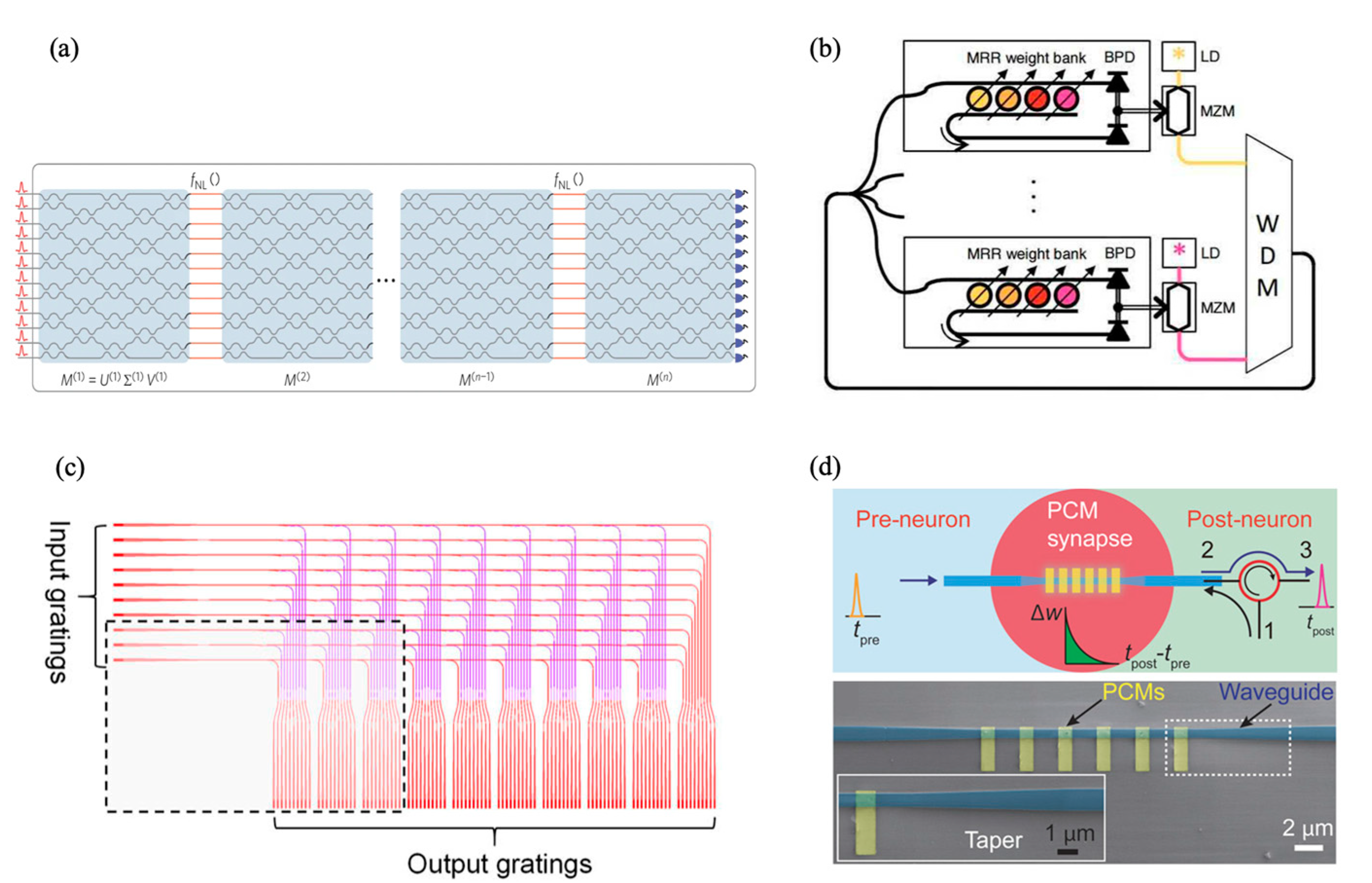
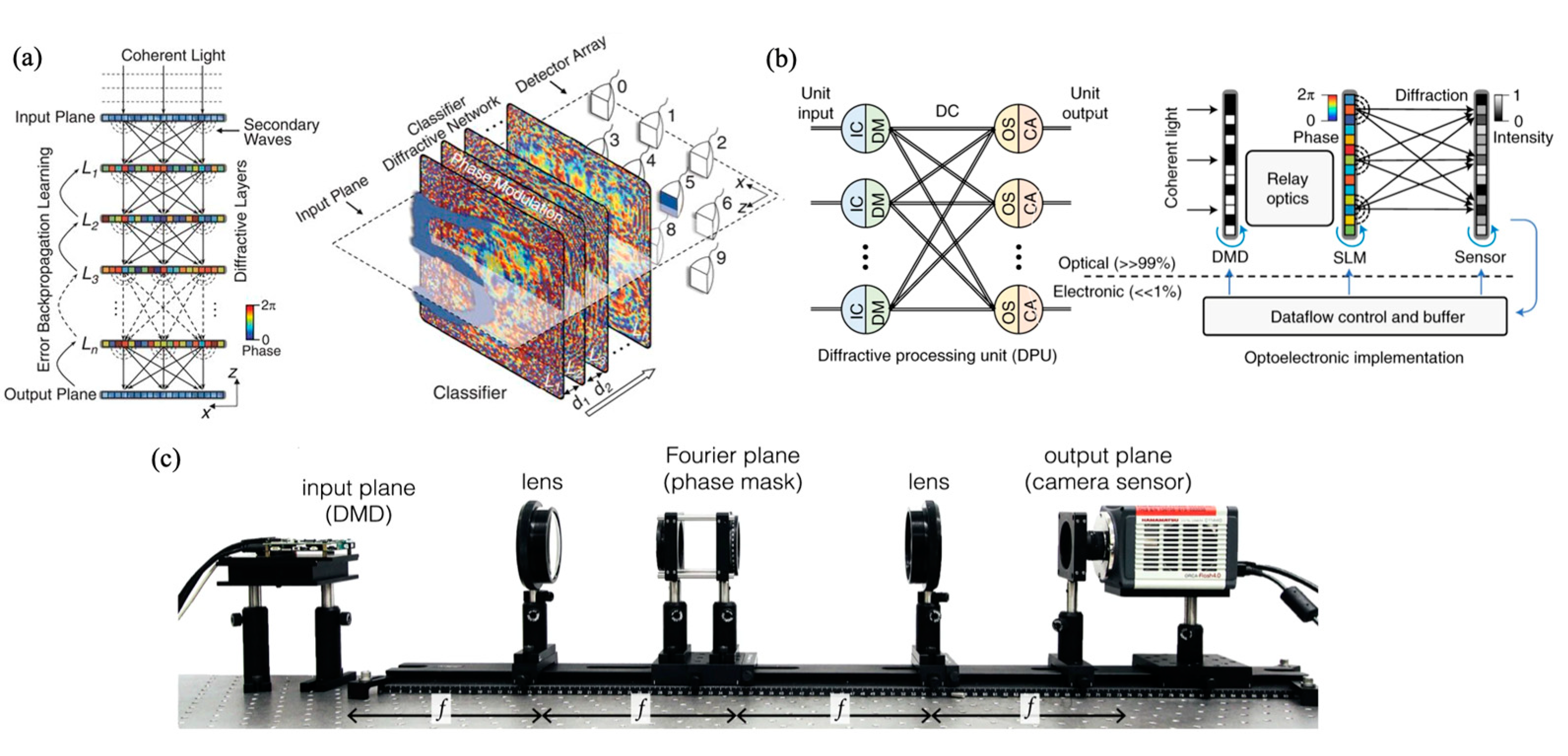
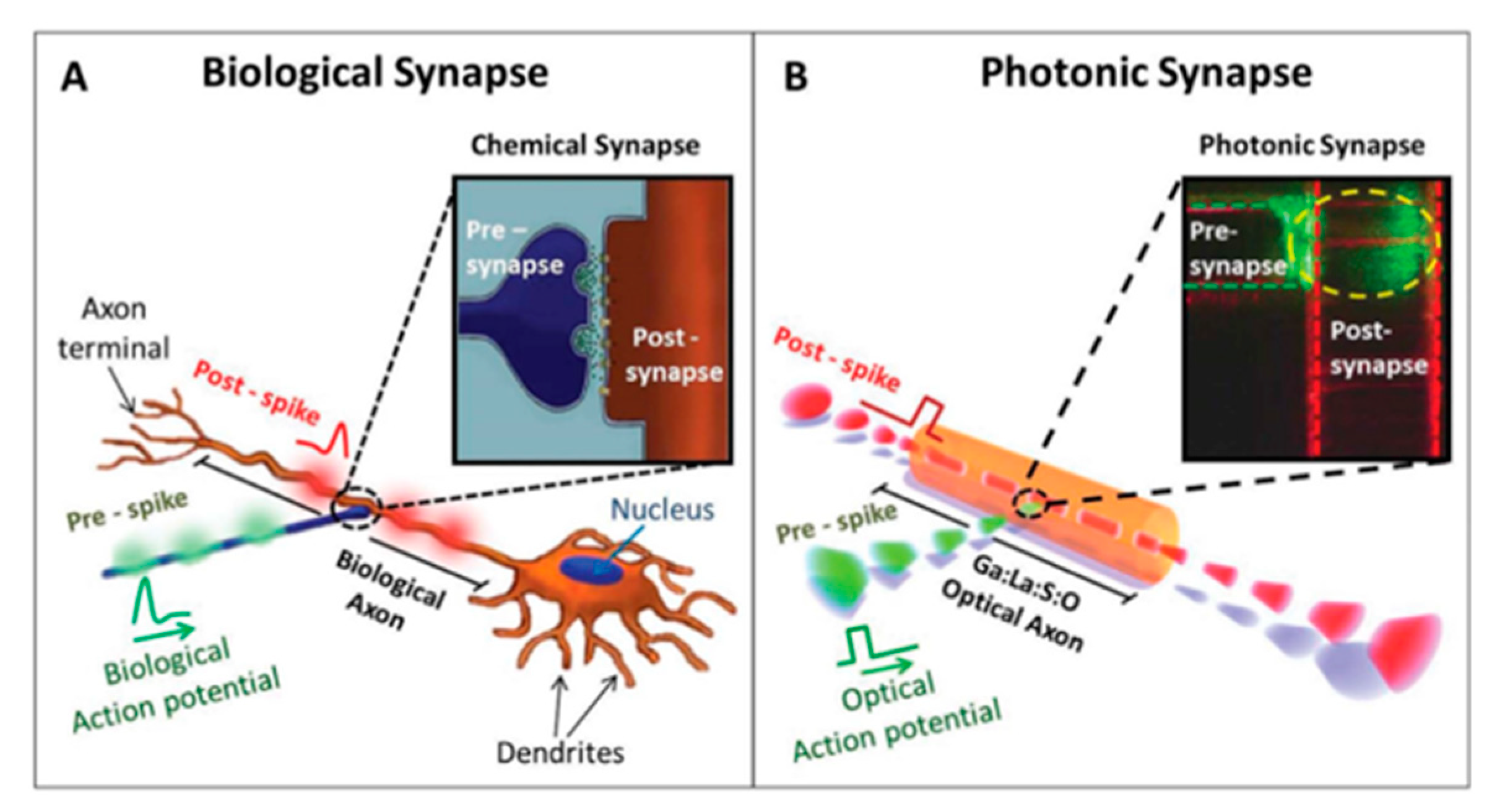
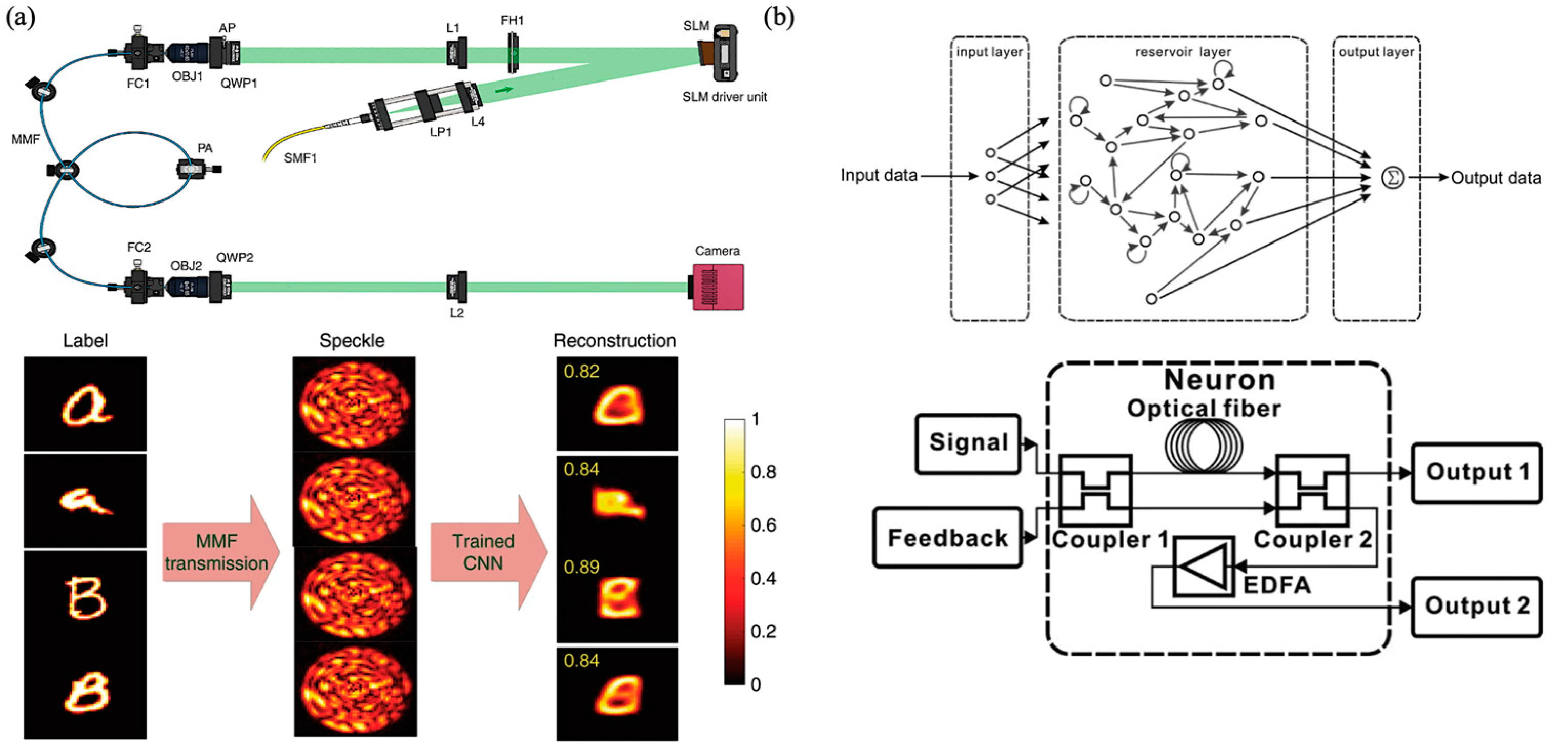
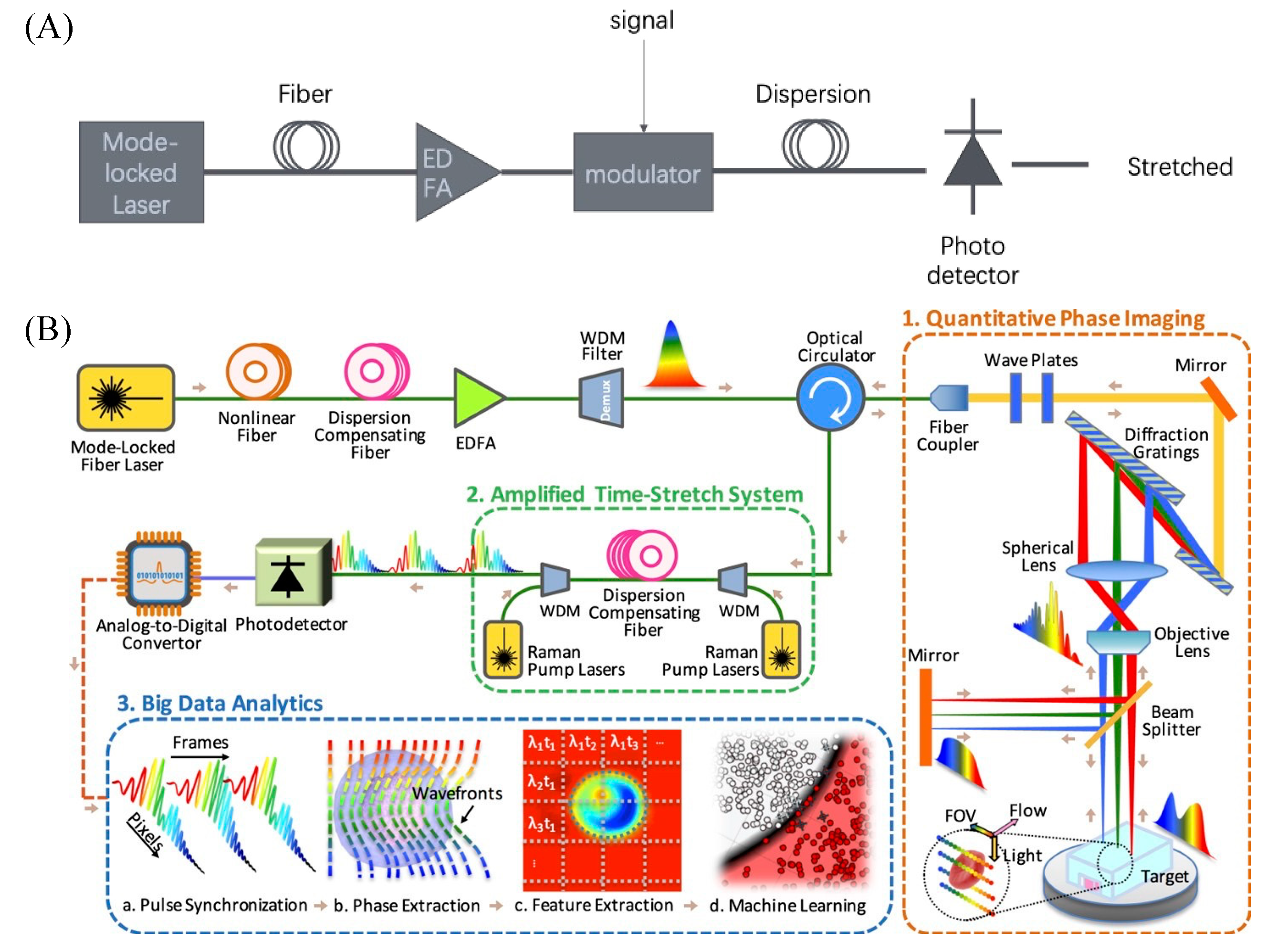
| Technology | Categories | Advantages | Disadvantages | Chip Capabilities |
|---|---|---|---|---|
| Silicon-based optical neural networks | Mach–Zehnder modulator scheme | Matrix multiplication has high speed and low power consumption | O/E conversion | Inference |
| Micro-loop modulator scheme | ||||
| 3D integration scheme | ||||
| D2NN | Optical diffraction | Handles large amounts of data | Not conducive to reuse | Inference |
| Fiber-based optical neural networks | Microfiber | Wavelength division multiplexing, biological-like neurons | Large size | No chip |
| MMF | It has both linear and nonlinear functions | Not easy to control | ||
| PTS | Photon DAC | Massive system |
Publisher’s Note: MDPI stays neutral with regard to jurisdictional claims in published maps and institutional affiliations. |
© 2022 by the authors. Licensee MDPI, Basel, Switzerland. This article is an open access article distributed under the terms and conditions of the Creative Commons Attribution (CC BY) license (https://creativecommons.org/licenses/by/4.0/).
Share and Cite
Zhang, D.; Tan, Z. A Review of Optical Neural Networks. Appl. Sci. 2022, 12, 5338. https://doi.org/10.3390/app12115338
Zhang D, Tan Z. A Review of Optical Neural Networks. Applied Sciences. 2022; 12(11):5338. https://doi.org/10.3390/app12115338
Chicago/Turabian StyleZhang, Danni, and Zhongwei Tan. 2022. "A Review of Optical Neural Networks" Applied Sciences 12, no. 11: 5338. https://doi.org/10.3390/app12115338
APA StyleZhang, D., & Tan, Z. (2022). A Review of Optical Neural Networks. Applied Sciences, 12(11), 5338. https://doi.org/10.3390/app12115338






